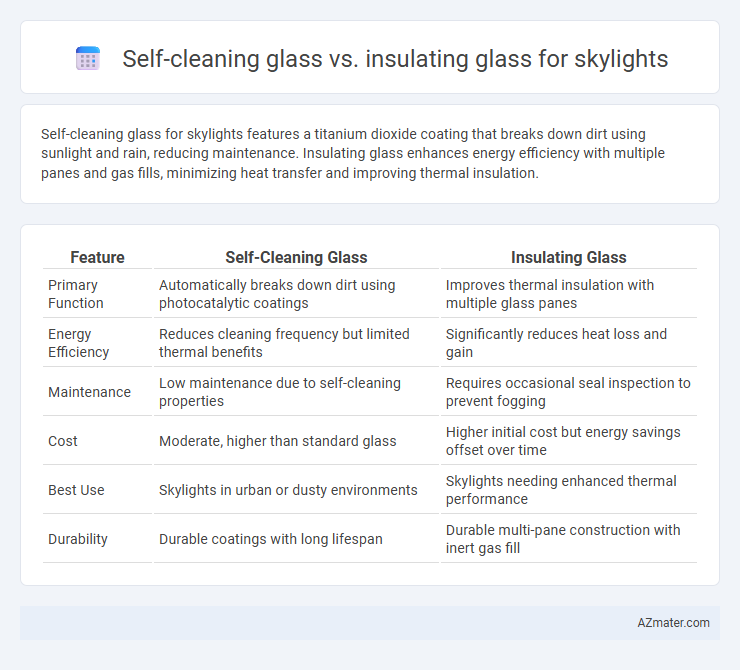Self-cleaning glass for skylights features a titanium dioxide coating that breaks down dirt using sunlight and rain, reducing maintenance. Insulating glass enhances energy efficiency with multiple panes and gas fills, minimizing heat transfer and improving thermal insulation.
Table of Comparison
| Feature | Self-Cleaning Glass | Insulating Glass |
|---|---|---|
| Primary Function | Automatically breaks down dirt using photocatalytic coatings | Improves thermal insulation with multiple glass panes |
| Energy Efficiency | Reduces cleaning frequency but limited thermal benefits | Significantly reduces heat loss and gain |
| Maintenance | Low maintenance due to self-cleaning properties | Requires occasional seal inspection to prevent fogging |
| Cost | Moderate, higher than standard glass | Higher initial cost but energy savings offset over time |
| Best Use | Skylights in urban or dusty environments | Skylights needing enhanced thermal performance |
| Durability | Durable coatings with long lifespan | Durable multi-pane construction with inert gas fill |
Introduction to Skylight Glass Options
Skylight glass options primarily include self-cleaning glass and insulating glass, each designed to enhance functionality and energy efficiency. Self-cleaning glass uses a special coating that breaks down organic dirt and allows rainwater to wash it away, reducing maintenance in hard-to-reach areas. Insulating glass features multiple panes with air or gas-filled spaces to improve thermal performance, minimizing heat loss and reducing energy costs in skylight installations.
What Is Self-Cleaning Glass?
Self-cleaning glass features a special coating that breaks down organic dirt using sunlight and washes it away with rainwater, reducing maintenance efforts. This coating typically involves a photocatalytic layer made from titanium dioxide, which enables the glass to stay clearer longer by preventing grime buildup. While insulating glass focuses on thermal performance and energy efficiency for skylights, self-cleaning glass enhances cleanliness and visibility with minimal cleaning required.
Understanding Insulating Glass for Skylights
Insulating glass for skylights consists of two or more glass panes separated by a spacer filled with air or inert gas, designed to reduce heat transfer and improve energy efficiency. This type of glass maintains indoor temperature by minimizing heat loss during winter and heat gain in summer, making it ideal for climate control in buildings. Compared to self-cleaning glass, insulating glass prioritizes thermal insulation and sound reduction, enhancing overall comfort and energy savings in skylight applications.
Key Differences: Self-Cleaning vs Insulating Glass
Self-cleaning glass for skylights features a special photocatalytic coating that breaks down organic dirt and uses rainwater to wash it away, reducing maintenance frequency. Insulating glass consists of multiple panes separated by a gas-filled space, significantly enhancing thermal efficiency and minimizing heat transfer. While self-cleaning glass prioritizes ease of upkeep and clarity, insulating glass focuses on energy conservation and temperature regulation.
Energy Efficiency and Thermal Performance
Self-cleaning glass for skylights features a special coating that reduces dirt accumulation, maintaining optimal light transmission and reducing maintenance, which indirectly supports energy efficiency by maximizing natural daylight usage. Insulating glass, often double or triple glazed with low-emissivity (Low-E) coatings and gas fills like argon or krypton, significantly enhances thermal performance by minimizing heat transfer, reducing heating and cooling loads. For energy efficiency and thermal comfort, insulating glass outperforms self-cleaning glass by providing superior insulation, while self-cleaning glass contributes mainly to long-term clarity and daylight efficiency.
Maintenance and Longevity Comparison
Self-cleaning glass for skylights reduces maintenance by utilizing a photocatalytic and hydrophilic coating that breaks down organic dirt and allows rainwater to wash it away, extending the period between cleanings. Insulating glass, designed with multiple panes and gas fills to enhance thermal performance, requires routine maintenance of seals and spacers to prevent fogging and loss of insulation, impacting its longevity. While self-cleaning glass cuts down on manual cleaning efforts, insulating glass offers superior thermal efficiency but may require more frequent inspections to maintain its insulating properties over time.
Cost Analysis: Initial Investment and Long-Term Savings
Self-cleaning glass for skylights typically demands a higher initial investment due to advanced coatings that reduce maintenance costs and extend cleaning intervals. Insulating glass, while often more affordable upfront, provides significant long-term energy savings by enhancing thermal performance and reducing heating and cooling expenses. Evaluating overall cost efficiency requires balancing the premium of self-cleaning technology against insulating glass's potential to lower energy bills over time.
Aesthetic Impact and Visual Clarity
Self-cleaning glass for skylights maintains aesthetic appeal by reducing dirt accumulation, ensuring long-lasting transparency and minimal maintenance streaks. Insulating glass enhances visual clarity by incorporating multiple panes with low-emissivity coatings that reduce glare and improve light insulation. Both technologies optimize skylight performance, but self-cleaning glass prioritizes sustained cleanliness, while insulating glass focuses on thermal efficiency and clear, unobstructed views.
Ideal Applications for Self-Cleaning and Insulating Glass
Self-cleaning glass is ideal for skylights in locations with limited access for maintenance, such as high-rise buildings or hard-to-reach roofs, where minimizing manual cleaning is critical; it uses a special coating that breaks down organic dirt and allows rainwater to wash it away. Insulating glass, featuring multiple panes with gas fills and low-emissivity coatings, is best suited for climates requiring enhanced thermal performance to reduce heat loss or gain, improving energy efficiency and indoor comfort. For skylights combining both benefits, hybrid solutions offer self-cleaning coatings on high-performance insulating glass units, providing optimal maintenance ease and superior insulation.
Choosing the Right Skylight Glass for Your Needs
Selecting the right skylight glass depends on balancing energy efficiency and maintenance priorities; self-cleaning glass features a hydrophilic coating that breaks down organic dirt and washes it away with rain, reducing upkeep. Insulating glass, typically double or triple glazed, offers superior thermal performance, minimizing heat loss and gain to improve indoor comfort and lower energy costs. For high-maintenance areas or hard-to-reach installations, self-cleaning glass is beneficial, while insulating glass excels in climates demanding enhanced insulation.

Infographic: Self-cleaning glass vs Insulating glass for Skylight
 azmater.com
azmater.com